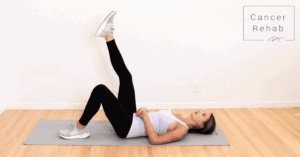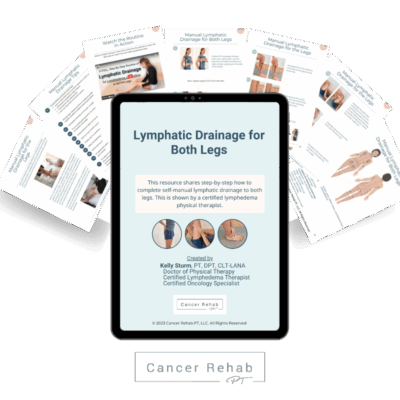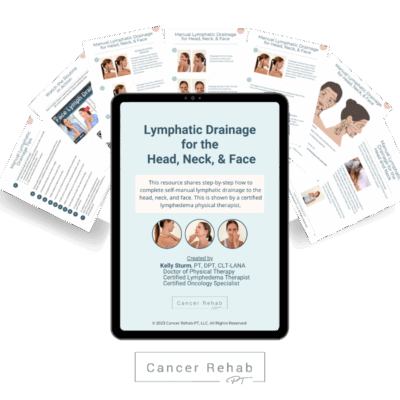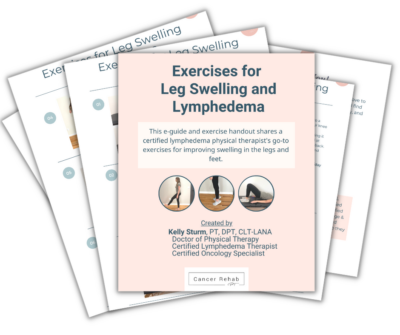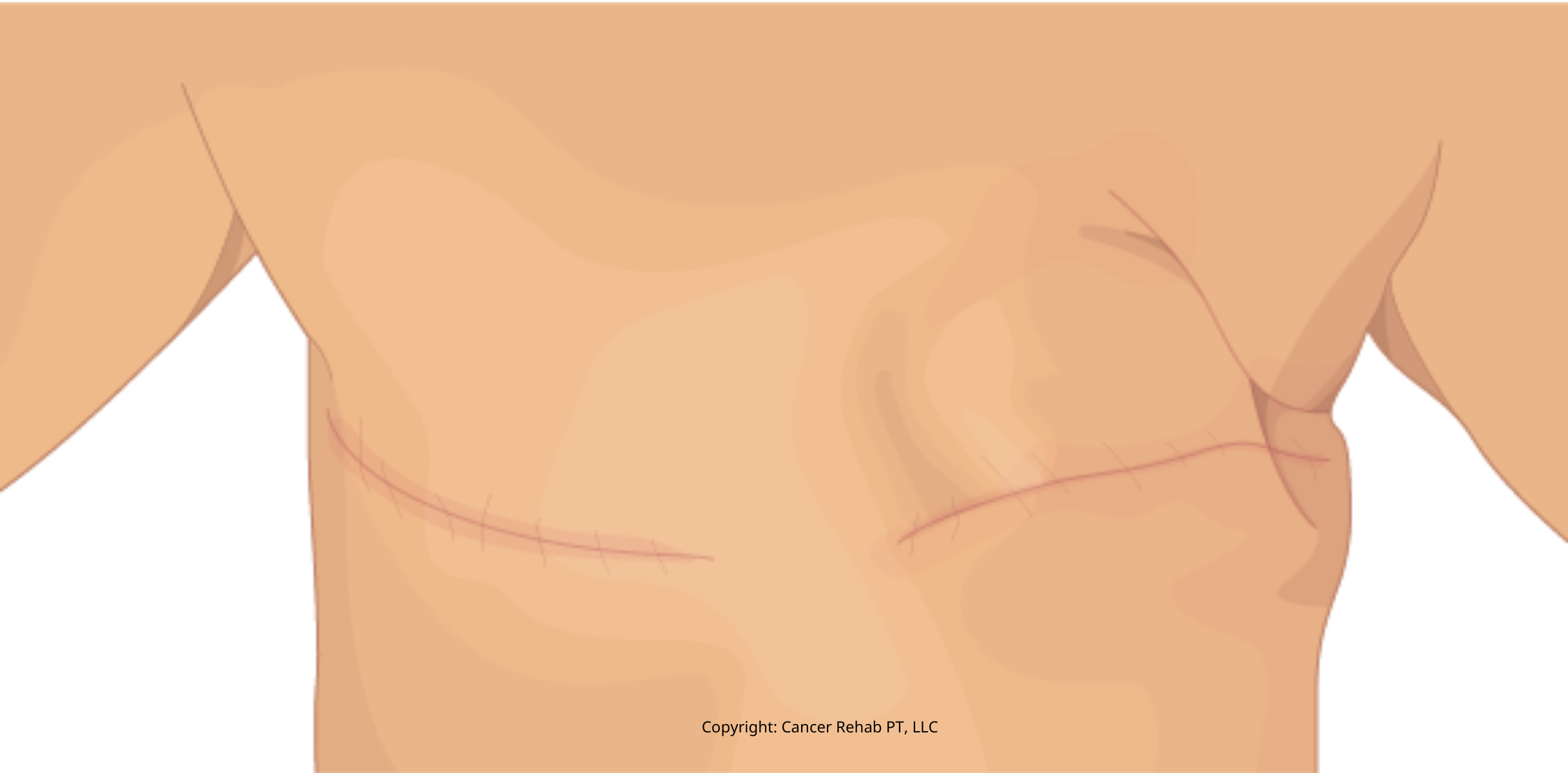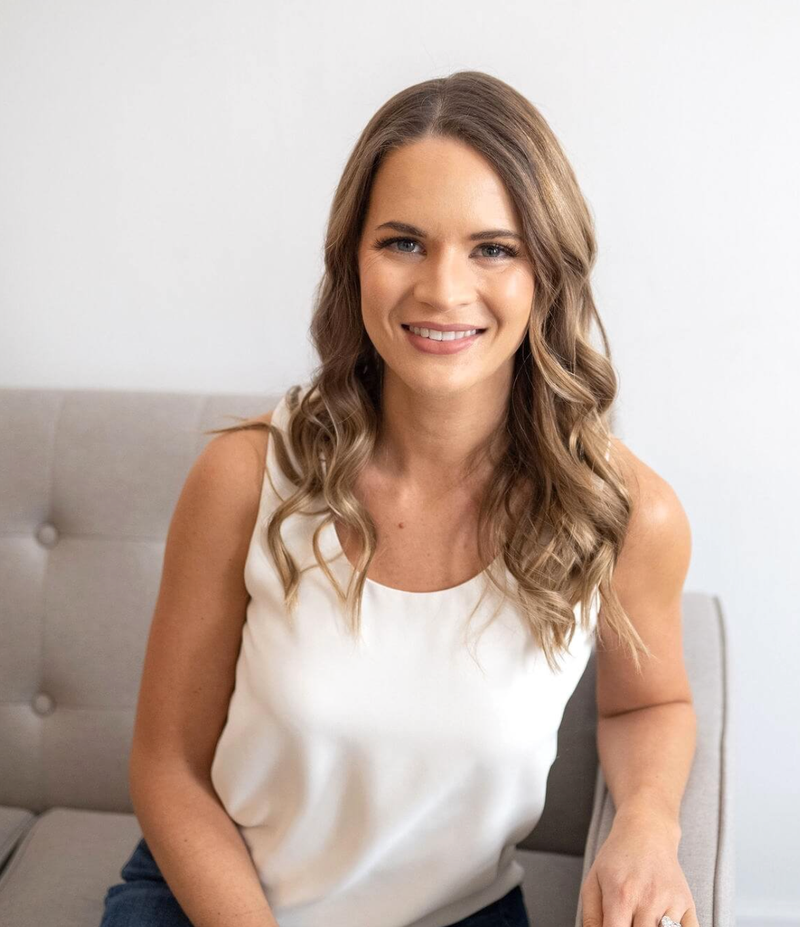If you’re facing breast cancer surgery or have recently had one, you likely have questions about what to expect from your mastectomy scars. As a Physical Therapist and a Board-Certified Oncology Clinical Specialist, I’ve met many people who share these concerns.
Scarring is a natural part of the healing process. But understanding what to expect and how to care for your mastectomy scars can help you feel more confident in your recovery. Discomfort and limitations don’t have to become your new normal after breast surgery.
You can also find more support for breast cancer recovery – including scar tissue management – in Breast Cancer Rehab.
Why Do Mastectomy Scars Form?
Scar formation is your body’s natural response to healing after surgery. When an incision is made during a mastectomy, your body immediately begins its repair process by producing collagen – a protein that helps rebuild and strengthen the damaged tissue.
Everyone has mastectomy scars after surgery, but their appearance and how they feel can vary significantly from person to person.
Sometimes, scar tissue becomes bothersome. You may experience:
- Tightness that restricts movement
- Pulling sensations during certain activities
- Pain or discomfort when reaching or stretching
- Adhesions where scar tissue attaches to underlying tissues
- Numbness or altered sensations around the scar
- Difficulty with certain exercises or movements
These challenges are often manageable with proper care, such as using topical treatment products and scar massage. Even if you still have scar tissue pain years after mastectomy, there are steps you can take to improve your quality of life.

How Different Types of Mastectomies Scar
A mastectomy is a breast cancer surgery that removes breast tissue. There are different types of mastectomy procedures, and your doctor will recommend the best option for your situation based on factors like the type of cancer, its location, and if you’re planning on breast reconstruction.
Since the surgical procedures are different, there are different types of mastectomy scars as well.
Partial Mastectomy
During a partial mastectomy, the surgeon removes just a portion of the breast – the tumor and a small amount of the healthy tissue around it. Most of your breast stays intact.
The scar is usually small, appearing as a short curved or straight line where the tumor was taken out.
Skin-Sparing Mastectomy
This surgery removes all the breast tissue but keeps most of your breast skin in place. You may get a skin-sparing mastectomy if you’re planning on breast reconstruction surgery.
The scar usually circles where your nipple and areola were, sometimes with a short line extending from it to allow your surgeon to remove the breast tissue.
Nipple-Sparing Mastectomy
This surgery saves your nipple and the dark skin around it (called the areola). The scar is usually hidden in the natural fold under your breast or along the side. This option works well for some early-stage cancers or when surgery is being done to prevent cancer.
Simple or Total Mastectomy
This surgery removes all breast tissue, including your nipple and areola. You’ll have one main scar that runs side to side across your chest.
Modified Radical Mastectomy
This is similar to a total mastectomy, but your surgeon also removes lymph nodes from under your arm. You’ll have the same side-to-side scar across your chest, plus some small scars under your arm where the lymph nodes were removed.
Prophylactic Mastectomy
This is preventive surgery for people with a high risk of developing breast cancer – it’s done before a breast cancer diagnosis. The mastectomy scars depend on the technique your surgeon uses, and many people choose nipple-sparing or skin-sparing options when possible.
Double Mastectomy
When both breasts are removed, you’ll have matching scars on each side of your chest. The exact look depends on your choices.
If you get implants, the double mastectomy scars might follow the natural curve under where your breasts were. Without reconstruction, you’ll have straight lines across each side.
If you use your own body tissue for reconstruction, you’ll also have scars where that tissue was taken (often from your belly or back).
Single Mastectomy
This surgery removes one breast, so you’ll have single mastectomy scars on just one side. Some people choose to have reconstruction on the surgery side or use an external breast form that fits in a special bra.
Mastectomy Reconstruction Scars
Reconstruction scars can vary based on the type of reconstructive surgery you choose. With implant-based reconstruction, scars may be limited to the breast area.
However, if you’ve opted for natural tissue reconstruction, you’ll have additional scars at the donor site, typically on your abdomen or back.
The Bottom Line
Mastectomy scars are permanent, but they usually fade over time and become less noticeable – especially with proper care.
Breast cancer awareness and educating yourself on how to manage uncomfortable symptoms such as tightness can help reduce scarring.
Learn more about breast cancer rehabilitation.
What Do Mastectomy Scars Look Like?
If you’re facing breast cancer surgery, it’s normal to wonder what mastectomy scars look like.
When your scars are fresh, they typically appear pink or red and might feel raised to the touch. Some people notice that their scars look:
- Slightly puffy or elevated above the surrounding skin
- Pink, red, or darker than their natural skin tone
- Firm when touched
- Different in texture from the surrounding skin
- Like a thin line or a wider band, depending on the surgery type
Mastectomy scars never completely disappear, but they usually change and improve over time.
As your body continues to heal, the collagen in your scar tissue slowly matures. This means that your scars will fade to a lighter color, become softer, and blend better with the surrounding skin.
Photos of Mastectomy Scars
Here are a couple of photos of mastectomy scars that members of the Cancer Rehab PT community have shared with me.
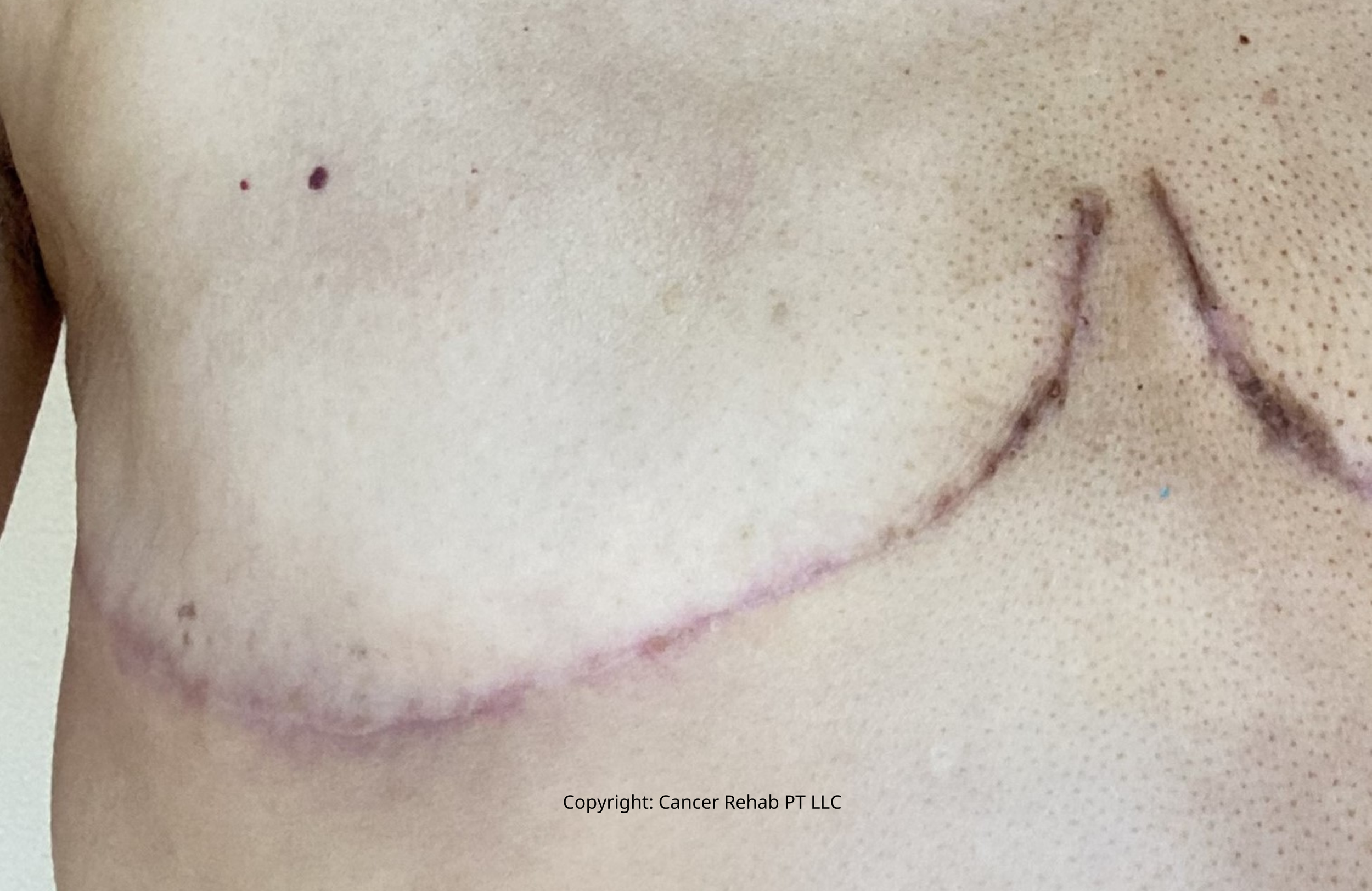

How to Improve Mastectomy Scar Appearance
There are a few things you can do to help minimize the appearance of scar tissue after surgery:
- Keep the incision clean and dry to prevent infection (the risk of an infection is typically 4% for an average healthy person)
- Follow your doctor’s instructions on when to change the dressing and return for follow-up visits
- Avoid picking at or scratching the scar
- Avoid sun exposure and use a broad-spectrum sunscreen with a high SPF
- Massage the scar gently with a moisturizing lotion to help soften and flatten the scar
- Use topical scar treatment products, such as silicone sheets or creams, as recommended by your doctor or breast surgeon
It is important to keep in mind that everyone’s healing process is different, and it may take time for the scar to fully mature.
Risk Factors for Mastectomy Scars
Certain scenarios and risk factors make you likely to have more scar tissue. These include:
- Surgical Technique: The method your surgeon uses and the size of incisions can affect how much scar tissue forms after surgery.
- Infection: Getting an infection at your surgical site can lead to more scarring, which is why keeping the area clean and following proper wound care is so important.
- Genetics: Some people are naturally more prone to scarring after surgery due to their genetic makeup.
- Age: As we get older, our skin changes and becomes less elastic, which can lead to more noticeable scar tissue formation.
- Radiation Therapy: If you need radiation after surgery, you might develop more scar tissue or experience pain because radiation can affect your skin and tissues.
- Health and Lifestyle: People with chronic conditions like diabetes, immune system disorders, or those who smoke may experience more scar tissue pain and slower healing after a mastectomy.
Knowing these risk factors helps you take proactive steps to minimize the symptoms and appearance of your mastectomy scars.
You might also be interested in learning more about cording after mastectomy and breast-cancer-related shoulder pain.
How Long Will It Take to Recover from a Mastectomy?
According to the National Breast Cancer Foundation, mastectomy recovery can take anywhere from 2 to 4 weeks depending on the type of surgery you had.
The first few days after surgery are typically spent in the hospital, where your medical team will help manage pain and monitor your healing. Once home, you’ll need to limit your activities and avoid heavy lifting or strenuous arm movements for several weeks.
If you’ve had reconstruction at the same time as your mastectomy, or if you’re also going through other treatments like radiation or chemotherapy, your recovery might take longer.
Do Mastectomy Scars Ever Go Away?
Mastectomy scars are permanent and don’t completely go away, but they become much less noticeable over time.
During the first few months after surgery, your scars may appear pink or red and feel raised and firm. As your body continues to heal, the scars typically fade to a lighter color, become softer, and flatten out – especially with proper scar care like gentle massage and sun protection.
Symptoms like pain, tightness, and discomfort around your mastectomy scars usually improve significantly with time and proper management as well.
Working with a physical therapist or joining a program like Breast Cancer Rehab helps you speed up recovery.

Mastectomy Scars Tightness
After a mastectomy, many people experience tightness around their scars. This happens because scar tissue behaves differently from your normal skin – it’s less flexible and elastic, which can make the area feel tight and restricted.
You might notice this tightness most when trying to reach overhead, stretch your arms wide, or even during simple activities like getting dressed or washing your hair.
Scar tissue can also attach itself to deeper layers of your body, including muscles and tendons. When this happens (a process called adhesion), it might cause additional symptoms beyond just tightness.
You might feel pulling sensations, weakness in your arm or chest muscles, or pain when moving in certain ways.
These symptoms are common, but you don’t have to accept them as a normal part of your life. Most mastectomy scars get better with proper care.
Soft Tissue Mobilization for Mastectomy Scars
One effective way to manage scar tightness is through soft tissue mobilization. It’s a specialized type of manual therapy that helps soften and release tight scar tissue.
This treatment is typically performed by a physical therapist who specializes in cancer rehabilitation.
During a session, which usually lasts 15-30 minutes, your therapist will use specific hands-on techniques to gently work with the scar tissue, followed by targeted stretching exercises to help maintain the improvements in flexibility.
With clearance from your doctor, you can also practice self-massage and stretching at home.
Before you begin any manual therapy, make sure to wash your hands to reduce the risk of infection.
FAQs
What Is the Best Thing for Mastectomy Scars?
The best approach for mastectomy scars is being proactive and educating yourself. Knowing what to expect after the surgery makes you more prepared and allows you to take steps that minimize scar appearance and uncomfortable symptoms, such as keeping the incision clean, avoiding sun exposure, and doing gentle self-massage.
In Breast Cancer Rehab, you can learn techniques to properly take care of your mastectomy scars.
Why Are Mastectomy Scars So Bad?
Mastectomy scars aren’t “bad” – they’re a natural part of the healing process and represent the body’s way of recovering from surgery. These scars can sometimes feel more noticeable because they’re in an area that affects daily movement and activities, and they might also be accompanied by changes in sensation or tightness. But with proper care and time, most mastectomy scars fade significantly and become less noticeable, both in appearance and how they feel.
When Is It Too Late to Massage Scar Tissue?
It’s never too late to start working with scar tissue. While starting scar massage early (once your doctor approves) can be helpful, even old scars can benefit from proper massage techniques and care. People often see improvements in flexibility and comfort even when starting scar tissue work months or even years after their mastectomy. Regardless of how long ago you had the surgery, you don’t have to live with discomfort and limitations.
What Is the Lump Under My Mastectomy Scar?
Small lumps or thickened areas under or around mastectomy scars are often normal scar tissue formation. This happens as your body heals and creates new tissue to repair the surgical area. However, it’s always important to have any new lumps checked by your healthcare team to make sure they’re normal scar tissue and not something that needs further attention.
Is It Normal to Have Pain Years After a Mastectomy?
Many people experience some ongoing sensations around their mastectomy site, but persistent pain and discomfort aren’t normal. There are many treatment options available, including physical therapy, that can help manage and reduce this pain.
How Long Does Tightness in the Chest Last After a Mastectomy?
Chest tightness after a mastectomy typically improves gradually over time, with most people noticing significant improvement within the first few weeks or months after the surgery. This tightness can also usually be improved with proper stretching, exercise, and scar tissue work.
Get More Support in Breast Cancer Rehab
With proper care, support, and time, many people find their mastectomy scars become less noticeable and easier to manage.
If you’re looking for more support after breast cancer, learn more about Breast Cancer Rehab! It has a dedicated in-depth program on managing scar tissue.
It also covers other important topics like reducing your risk of lymphedema, cording, rehab after radiation, and more.



